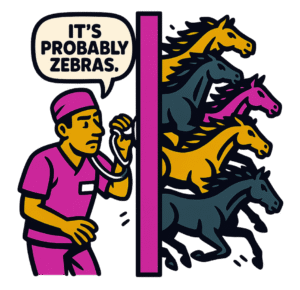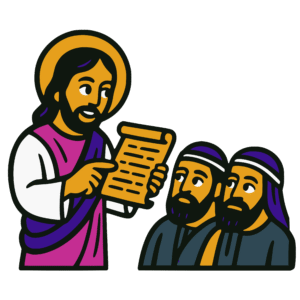
In the realm of medicine, physicians are taught a simple principle: “When you hear hoofbeats, think horses, not zebras.” It’s a reminder that the common explanation is usually the right one, and to assume otherwise without evidence is to risk needless error. Philosophers call this principle the law of parsimony, or Occam’s Razor: prefer the simpler explanation when multiple possibilities are on the table.
This principle is not only valuable in science and logic—it has tremendous relevance for how we approach the Bible. Too often, interpreters, both amateur and professional, bypass the plain sense of a passage in search of something more exotic, elaborate, or “deeper.”
But just as it is more sensible to assume a horse than a zebra when hoofbeats are heard, it is usually better to assume the straightforward meaning of a text before leaping to rare or speculative interpretations.
The Meaning of the Metaphor
Imagine you are standing in New York City and see the shadow of a bird passing overhead. Do you think pigeon or parrot?
- Pigeons are everywhere—ubiquitous on rooftops, sidewalks, and parks.
- Parrots do exist in the city, but only through unusual circumstances: they escaped from a pet shop, or someone released one from a cage.
Certainly, a parrot is possible. But in order for that possibility to be true, several additional assumptions must be stacked: a (likely wealthy) owner kept one, it escaped from its cage and from the home, it flew to this spot, and so on. Without clear evidence of green feathers or a squawk, the prudent answer is: pigeon.

So too in Bible study! When you explore a passage, the “pigeon” is the plain, ordinary sense of the words in their literary, historical, and grammatical context. The “parrot” is the rare allegorical, speculative, or deductive reading that could be possible, but requires a long chain of additional assumptions, becoming potentially implausible and assuredly improbable.
Parsimony guides us to stick with the pigeon unless the text itself requires us to think otherwise.
The Shoreline and the Stones
My friend Grant Hawley (of boldgrace.org) once presented me with this imagery. Imagine standing on the shoreline of a beach:

- The shoreline represents the plain sense of Scripture—the words as they are written, in their natural context.
- There are stones that extend into the water that represent assumptions, inferences, or theological deductions built on top of the text. One or two stones outward is reasonable. That’s what theology does: it connects dots, synthesizes, and draws larger conclusions from distinct portions of scripture.
- But the further you leap from stone to stone, the more precarious your footing. Each step depends not just on the text itself, but on your ability to balance on all the previous stones. Slip once, or have one stone give way, and you find yourself adrift and soon drowning in speculation, with no firm grounding in the actual word of God.
What Drowning Looks Like
Here are six practical ways this metaphor applies:
- Plain Reading (Shoreline):
“Love your neighbor as yourself” (Matt. 22:39). The plain meaning is clear: treat others with genuine care. - First Stone – Reasonable Theology:
From this, we can infer that the inverse (hatred or malice toward others) contradicts God’s will. A safe step outward. - Second Stone – Broader Synthesis:
“If someone says, ‘I love God,’ and hates his brother, he is a liar; for he who does not love his brother whom he has seen, how can he love God whom he has not seen?” We might connect this command in 1 John 4:20 to Matthew 22:39 and conclude that genuine love for God cannot exist without love for others. Still grounded. - Third Stone – Possible Extension:
Suppose then we claim that “if a person struggles to love their neighbor, they aren’t likely saved.” This leap goes beyond what the text explicitly states—it defends theology on deduction rather than direct teaching. Further, it threatens the face value interpretation of many other passages that stand in stark contrast to this theological extension. - Fourth Stone – Risky Theology:
Continuing further along that thread of thought, one might argue: “Only those who demonstrate perfect love consistently are truly Christians.” Now the shoreline is far behind. This is not Scripture speaking, but assumption piled upon assumption. - Out at Sea – Dangerous Speculation:
Ultimately, one might conclude that salvation itself depends on human works of love or obedience, not on the finished work of Christ. At this point, the interpreter is treading water in the open sea, vulnerable to collapse, and dangerously far from the safety of the shoreline.
Jesus Calls out the Parrots

The Sadducees are a striking example of what happens when prior bias drives interpretation away from the plain sense of Scripture. Because they had already rejected the principle of resurrection, they came to Exodus 3:6—where God declares, “I am the God of Abraham, the God of Isaac, and the God of Jacob”—and twisted it away from its natural force.
The “pigeon” solution was right there: God is (present tense) their God, which necessarily implies that Abraham, Isaac, and Jacob still live before Him. But instead of letting God’s Word speak plainly, the Sadducees forced a “parrot” reading, built on the assumption that if resurrection was not explicitly detailed in the Pentateuch, it must not exist. Their contorted interpretation shows how bias can lead us to multiply assumptions and miss the straightforward meaning—the very error Occam’s Razor cautions us against.
Occam’s Razor Empowers Us to “Handle with Care”
Be diligent to present yourself approved to God, a worker who does not need to be ashamed, rightly dividing the word of truth.
2 Timothy 2:15
Parsimony is not a call to simplistic thinking, nor does it deny the depth and richness of God’s Word. It is a call to humility, discernment, and restraint. It’s yet another way that we bolster God’s word in transforming us and not the other way around by …
- … reminding us that the plain sense of the text is usually the right place to stand.
- … warning against stacking unnecessary assumptions that the text does not itself demand.
- … keeping our theology tethered to Scripture, rather than to speculative systems or imaginative leaps.

When we hear hoofbeats, we think horses, not zebras. When we hear cooing in NYC, we think pigeons, not parrots. Parrots and zebras certainly exist, but shouldn’t be assumed without justifiable evidence. When we read Scripture, we should aim to stay near the shoreline—the safe, solid ground of the word itself—before venturing out on stones that may not hold.


